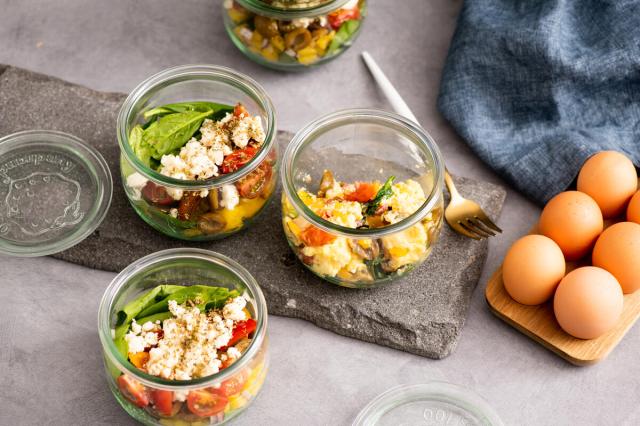
A week-long meal prep guide for low carb meals and snacks.
Master your low-carb lifestyle with savvy meal prep. Here’s a week’s worth of clever planning and shopping strategies and low carb meal plans. plus learn how to get creative with leftovers and discover top money-saving hacks and essential tools for meal prep and storage:
Planning, Shopping and Money-Saving Meal Prep Tips
Have a plan. Before you hit the grocery store, plan your meals and snacks for the week. Think about which ingredients you can use in multiple dishes.
Shop seasonally and locally. Produce that is in season is generally less expensive and tastes better. Local farmers’ markets can be a wealth of fresh, seasonal produce.
Grow your own. Even a small herb or vegetable garden can save money. Fresh herbs can be costly in stores, but they are easy to grow, even if it’s just a pot on your windowsill.
Prep your veggies. Don’t let fresh veggies languish in the refrigerator until they rot. Wash and cut them up and store them in clear glass containers as soon as you return from the store. That way you can grab them for snacks or quickly add them to omelets, main dishes or salads.
Consider canned veggies. Fresh veggies are a great value for the price, but they can become costly if they spoil and you must throw them away. Augment your selection of fresh veggies with canned vegetables like tomatoes. They can be just as nutritious and cost-effective and are the perfect long-lasting pantry staples for many meals.
Use grocery apps. Many supermarkets have apps that offer discounts, coupons and loyalty rewards.
Stick to your list. Make your list and stick to it to prevent unnecessary spending. Have a low carb snack before you go to the store to avoid hunger-induced impulse buys.
Repurpose proteins. Roast a chicken (or buy a rotisserie chicken) for one meal and use leftovers for salads, wraps or stir-fries. Add leftover steak or grilled chicken to a hearty salad for lunch or turn it into fajitas or tacos. You can also cook or grill up chicken, steak and fish and portion and freeze. Defrost whenever you need your protein of choice for a meal during the week.
Batch cooking. Also known as “cook once, eat twice.” Start with one basic recipe that can be adapted into different dishes. Think roasted vegetables and tomato sauces. Cook a large portion of meat sauce, like Bolognese, and portion into containers for your freezer to pull out when needed. For example, you can top zucchini “noodles” or low carb pasta with Bolognese, then transform it into cheesy stuffed bell peppers for another meal.
Freeze the rest. Maximize your leftovers and freeze what you won’t finish this week and save it for a busy day when you can just defrost and reheat.
Buy in bulk. This can save you money, but make sure you consume or store the food you buy in bulk before it goes bad.
Use beans and lentils. These are affordable sources of protein that can be added to soups or salads.
Eggs aren’t just for breakfast. Eggs are another affordable protein source. Make a batch of hard-boiled eggs to keep on hand for quick, protein-packed snacks. Prepare and refrigerate low carb frittatas, quiches, egg bites or an “add an egg” scramble that you can heat up for quick breakfasts during the week. You can also serve these savory egg dishes for lunch or dinner. Simply pair it with a salad.
Get creative with salad. Take some of those hard-boiled eggs and throw together an egg salad, or make chicken, tuna or shrimp salad, which you can serve with veggies or spoon into a romaine lettuce leaf.
Pick cheaper cuts. Instead of chicken breasts, go for chicken thighs. Less expensive cuts of meat can be cooked to tenderness in a slow cooker or Instant Pot.
Must-Have Meal Prep Containers and Tools
Glass containers. They’re environmentally friendly, microwave-safe and don’t hold onto odors or colors from food. Look for glass containers with airtight seals to keep your meals fresh.
Bento boxes. Perfect for portion control and to keep different food items separate.
Silicone freezer bags. These reusable bags are great for storing soups, sauces or pre-portioned meals.
Label makers or markers. Label and date items, especially if you’re freezing them, so you know when they were prepared.
Slow cooker or Instant Pot. Throw the ingredients into your slow cooker or Instant Pot in the morning, set the cook time and return home to a hot meal. These are great for batch cooking or preparing tougher cuts of meat.
Food processor. Speeds up chopping and dicing, especially if you’re preparing meals for the entire week.
Digital kitchen scale. For precise measurements and portion control.
Low Carb and Keto Meal Plans
Let these meal plans be your guide for a week of eating for your low carb lifestyle:
